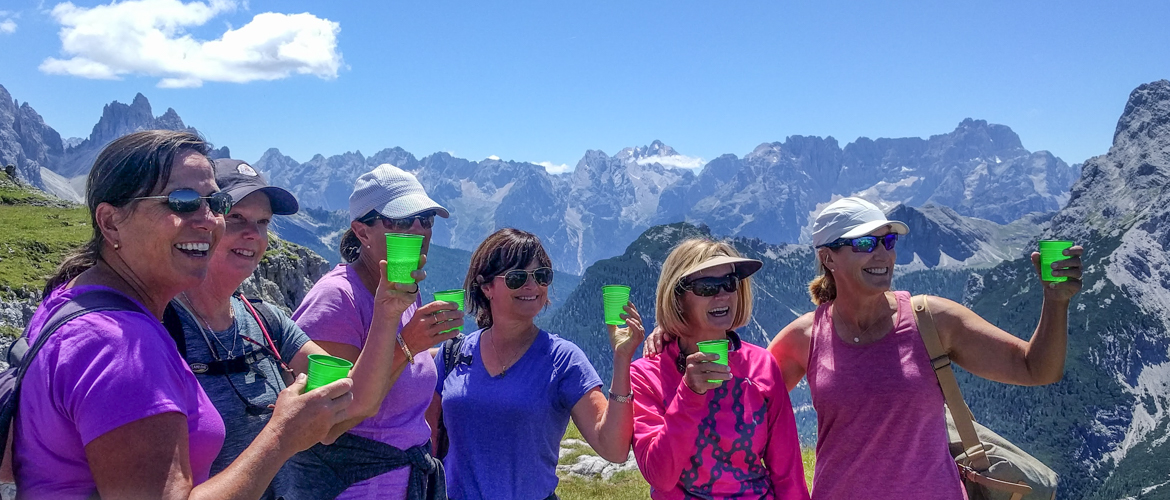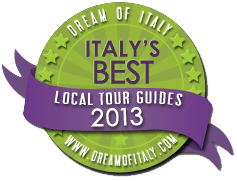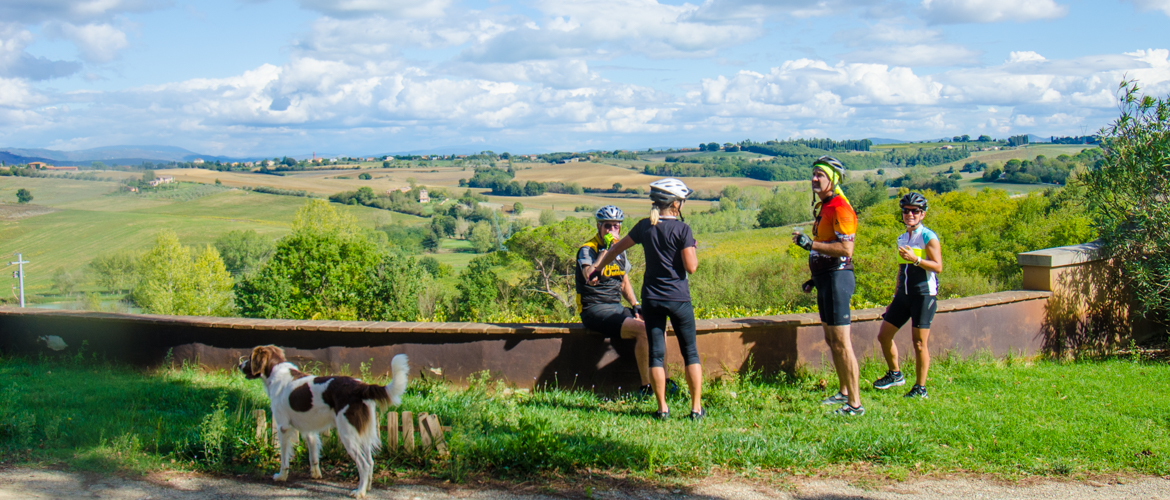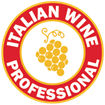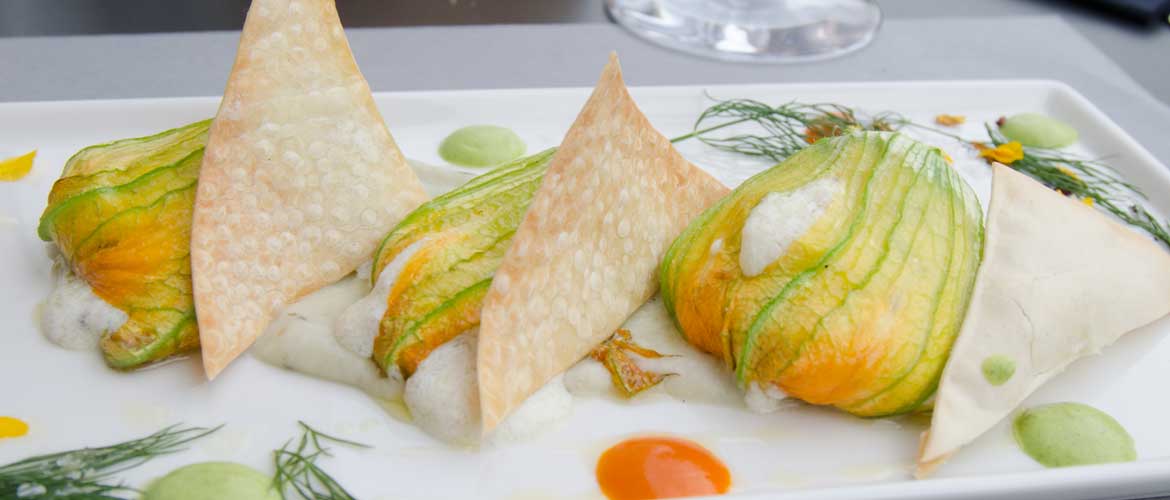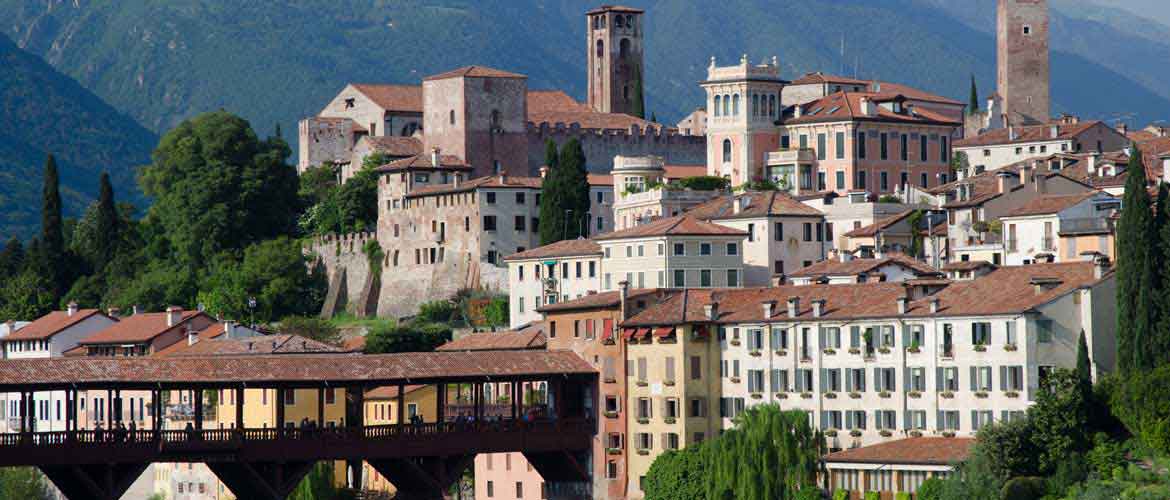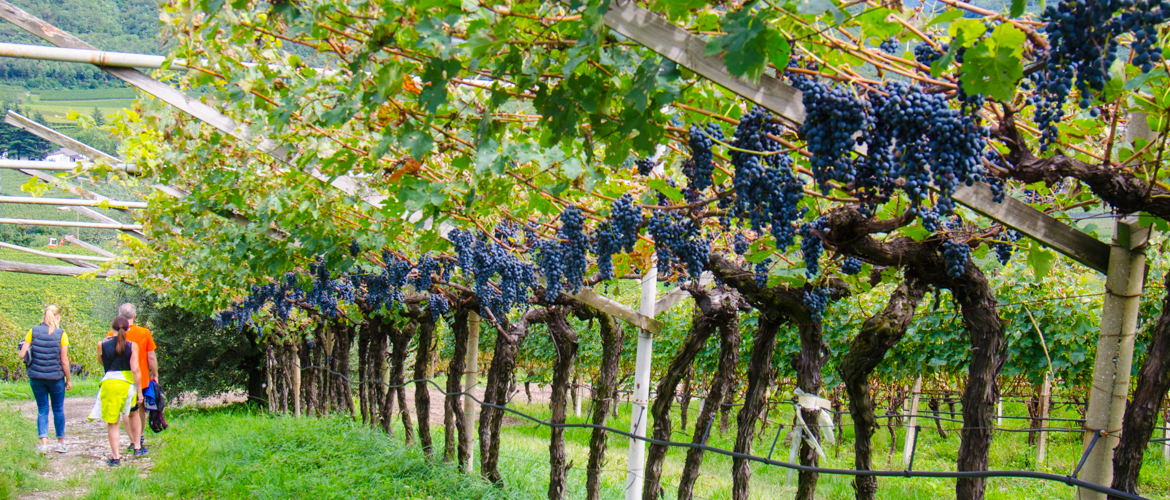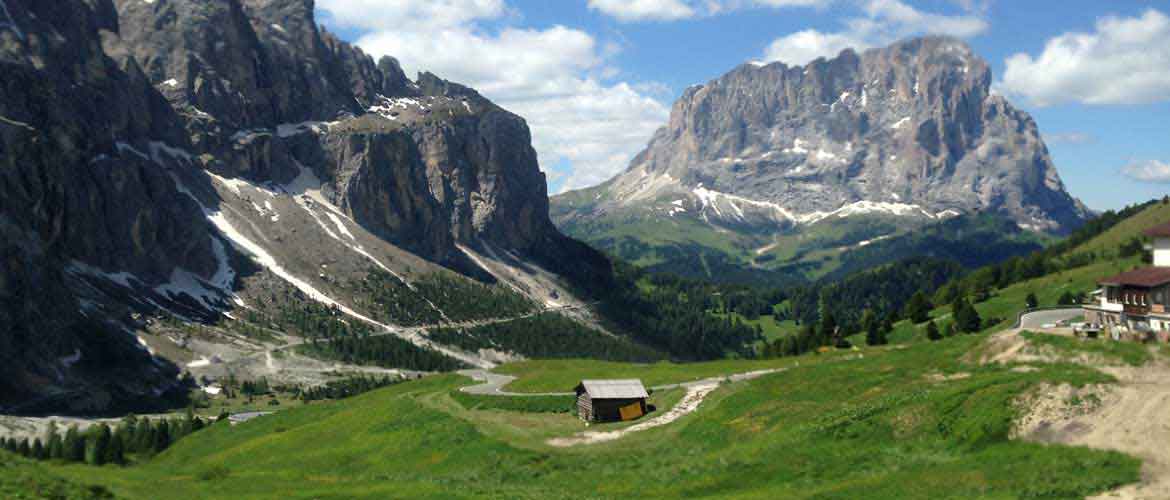The most famous, and most popular, after dinner drink in Northeastern Italy is grappa. It is primarily served as a digestivo, to aid in the digestion of a heavy meal. It can be served by itself, or added to espresso “caffe corretto”, an “ammazzacaffe”, where a few ounces of grappa are served after you finish your espresso, or a “resentin” (little rinser), where you rinse out your espresso cup with a few drops of grappa. However you choose to enjoy it, you will find a vast variety of grappa to taste on your visit.
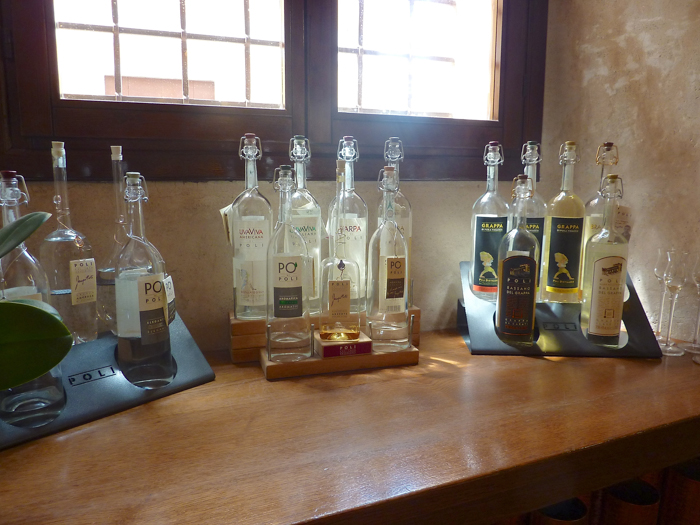
Grappa is similar to other distilled liquors, but is unique in that it is the only spirit made from distilling the skins, pulp, seeds and stems (called vinaccia) leftover from the winemaking process. Legend has it that a Roman solider first distilled grappa in Bassano del Grappa using equipment he stole from Egypt, but this is not the case, as the distillation techniques in use then could not produce grappa. According to Ove Boudin, in his book Grappa: Italy bottled, in ancient times the royalty would drink the wine, and the poor would make their own makeshift wine by adding water to the leftovers - nothing went to waste - calling it vinello. Around 1600, the Jesuits formalized and perfected distillation techniques, making it possible to distill vinaccia, and grappa was born.
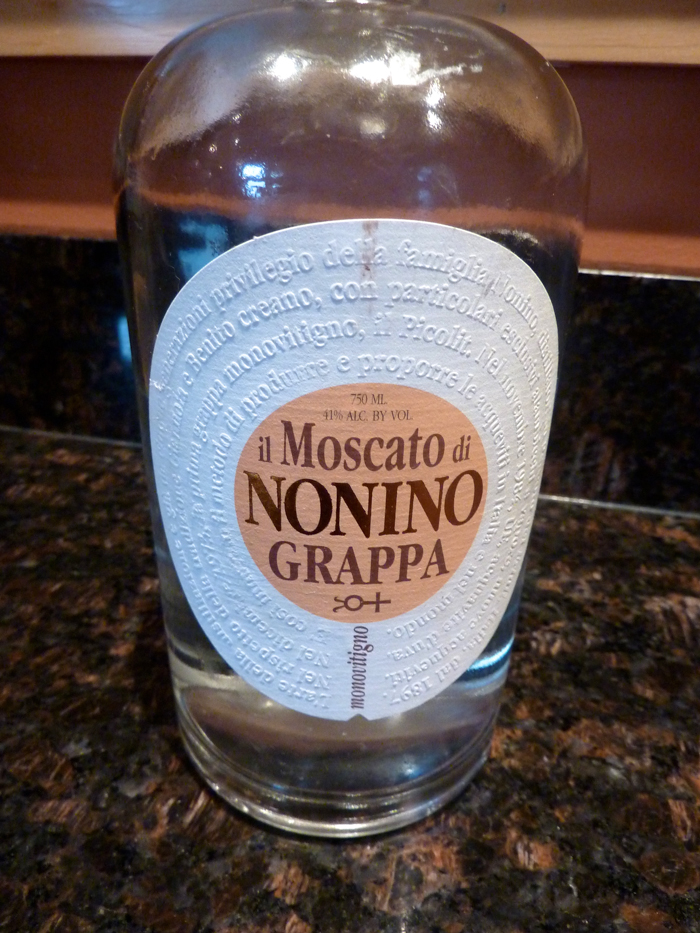
For many years, grappa was distilled with whatever vinaccia the producers would have available. Nowadays, as with most distilled liquors, modern producers have introduced refinements to the production process, greatly improving the final quality, and resulting in many diverse varieties. Today, the use of varietal grapes and aging in casks of various types of woods allows the producers to offer magnificent grappas that reflect the high quality and the unique nature of the original grapes. At the forefront here is Nonino, a Friuli based producer that was the first to introduce a single varietal grappa, made from Picolit, in 1973.
Grappa is now a name protected by the European Union. To be called grappa, the liquor must be produced in Italy, or certain parts of Switzerland or San Marino, be produced from vinaccia (also known as pomace), and fermentation and distillation must occur on the pomace, with no added water.
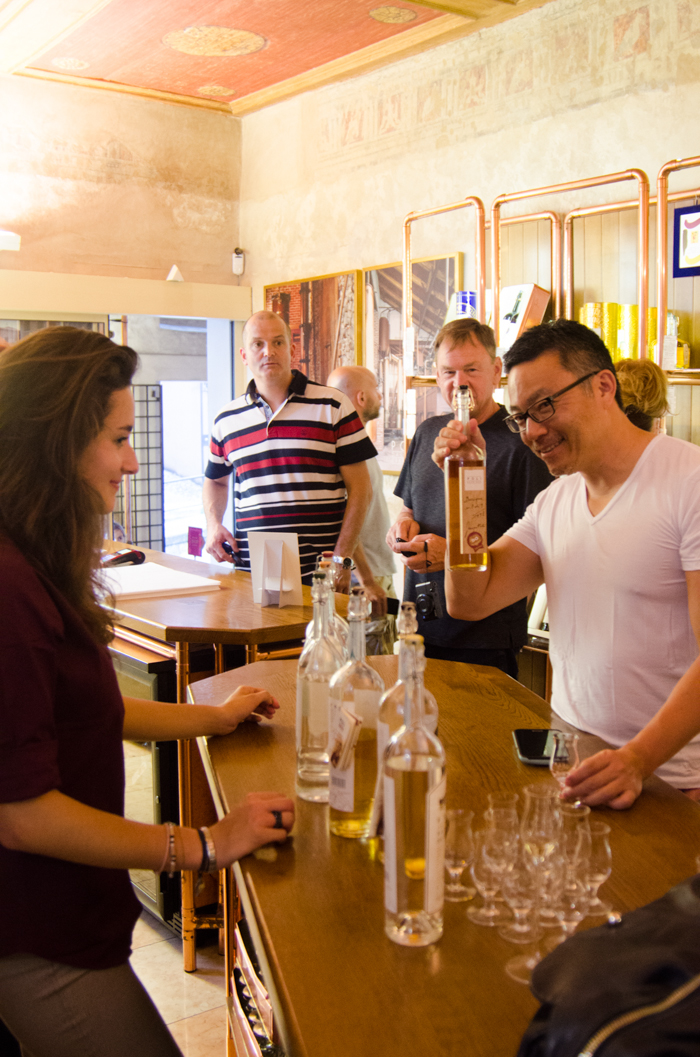
We visit Bassano del Grappa on our tours in Italy, and have the opportunity to visit two very well known producers that are right across the street from each other. Nardini is located at the end of the famous Ponte degli Alpini in Bassano, and is popular with the locales; you will see quite a crowd there, spilling out onto the bridge itself in the late afternoon. Poli is located here as well, and has a very interesting museum that leads you through the production process. Many small antique bottles are on display, and a ‘sniffing’ room, where you can explore the aromas of about 20 or so different grappas.
The most important cheese produced in Northern Italy is Grana Padano. It is produced all along the Po Valley, from Lombardia to the Veneto and into Trentino Alto Adige, where it is called Grana Trentino. Its origins date to around the 11th century, when Cistercian monks from the Chiaravalle Abbey near Milan began to drain the surrounding swamp land to use for agriculture and cultivation. Cattle farms appeared on this newly available, very fertile pastureland. These pastures provided exceptional quantities of new forage for the cattle, and soon the many cattle were producing much more milk than could be used on a daily basis. The farmers needed some way of utilizing or preserving the milk that was not immediately consumed.
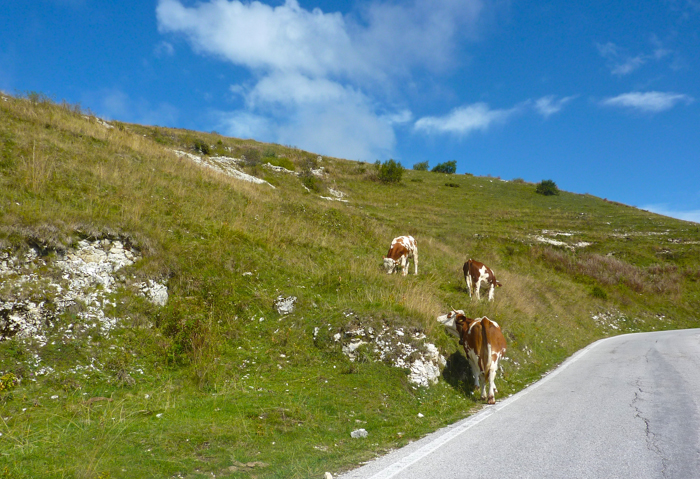
The monks happened upon a method of turning the perishable milk into a hard rind cheese that actually improved with a long period of aging. The cheese created by the method discovered by the monks became very popular, and by the 15th century production had spread throughout northern Italy, with Vicenza in the Veneto becoming a major production area where considerable cattle farms were producing large quantities of milk. Trade records of the 15th and 16th centuries record the exchange of this cheese, which became very popular in the cuisine of the region.
Grana Padano cheese is still produced in much the same way. It is manufactured from cow’s milk from the two milkings, drawn early in the morning and late in the day of the same day, then partially skimmed by allowing the cream to rise to the top. The milk is then transferred to a copper pot which holds enough milk for two cheeses.
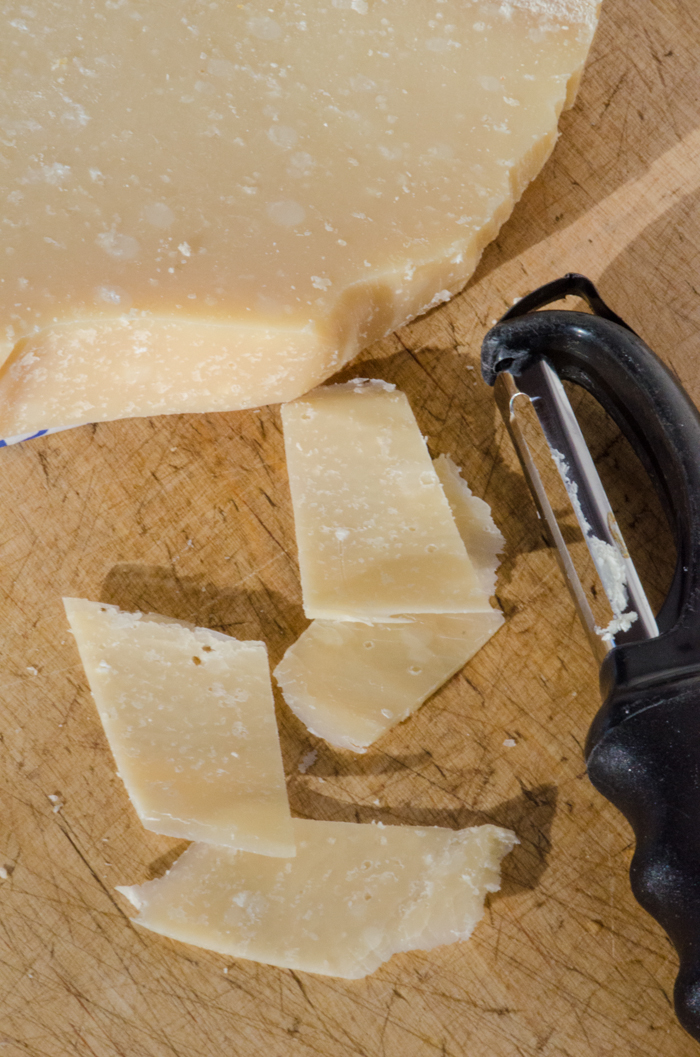
Rennet is added, and It is heated slightly to encourage coagulation. The curds are cut into very small pieces, and then it is cooked twice. The cooked curds are removed using cloths and placed into two moulds. These moulds are turned over several times and then salted in a brine bath for 28 days. After brining, the rounds are ripened and aged in a temperature and humidity controlled environment for 12 to 36 months, where they are checked, cleaned, and turned over regularly.
After aging, the cheese has a dark yellow or golden brown rind which is hard, smooth and thick. True Grana Padano must bear the mark of the Grana Padano Consortium. Grana Padano from Trentino, and from Trentino only, can additionally be marked with its place of origin. The body of the cheese is straw-yellow, flaky, and granular, with no holes. It can be used for grating, or as a table cheese.
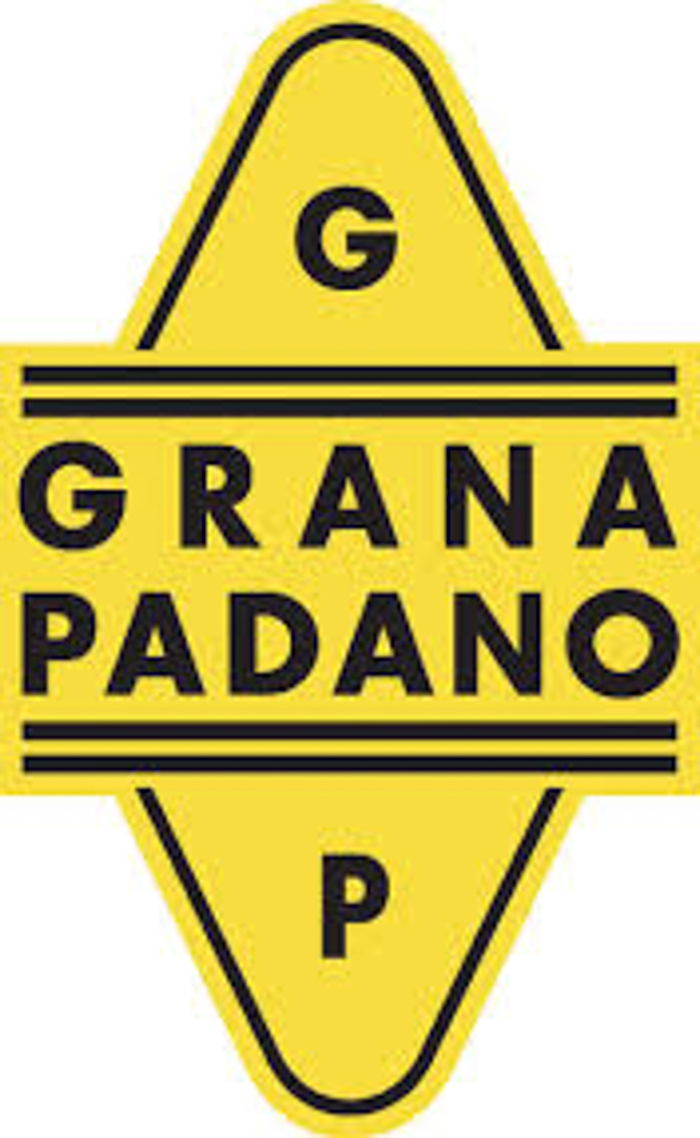
In 1996, Grana Padano cheese was classified as a DOP (Denominazione di Origine Protetta). This designation assures the consumer that the cheese has been produced according to specific standards regulating the raw ingredients (breed of cows, where they graze, what milking are used), production process and aging procedures. If the cheese meets these strict quality standards, the rind is fire branded with the mark of the Consortium for the protection of Grana Padano.
Pizza and pasta are considered by many to be the ‘staple’ starches in the standard Italian diet, but polenta in northern Italy is just as common. Northern Italians literally survived on this staple for hundreds of years.
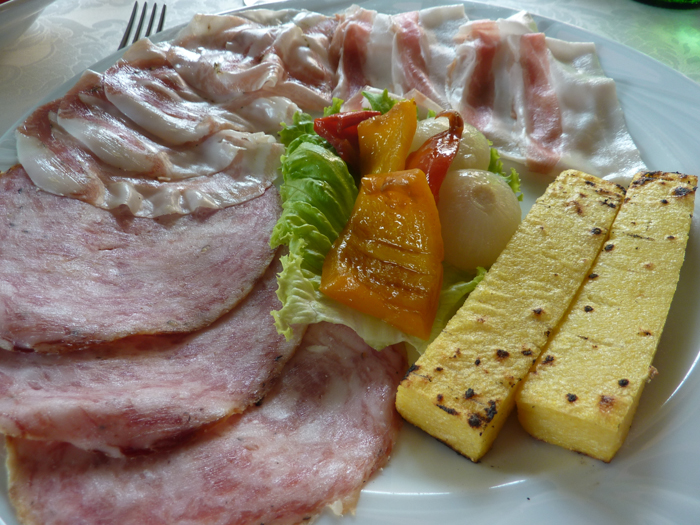
In ancient times, polenta was first made with wild grains from primitive wheats including faro, millet, spelt, and chickpeas. These would be mixed with water to form a paste, then cooked on a hot stone. This whole grain polenta would have had a very coarse texture. In time, milling techniques were improved, and flour “farina” was used. “Pulmentum” was a basic source of nutrition to the Roman soldiers, and at this time was actually preferred over bread for its flavor and simplicity by the soldiers and lower classes alike.
Polenta as such continued to be prepared in a similar manner for several hundred years, until the Saracens introduced buckwheat, or ‘grana saraceno’ to Italy. This became the most popular grain used for polenta (and is still used today in Tuscany and northern Italy) until the 15th or 16th century, when corn, or maize, was introduced. At this time, Spanish and Portuguese ships traveling from the Caribbean to Europe would bury their treasures and gold in flint corn to conceal it from marauding pirates.
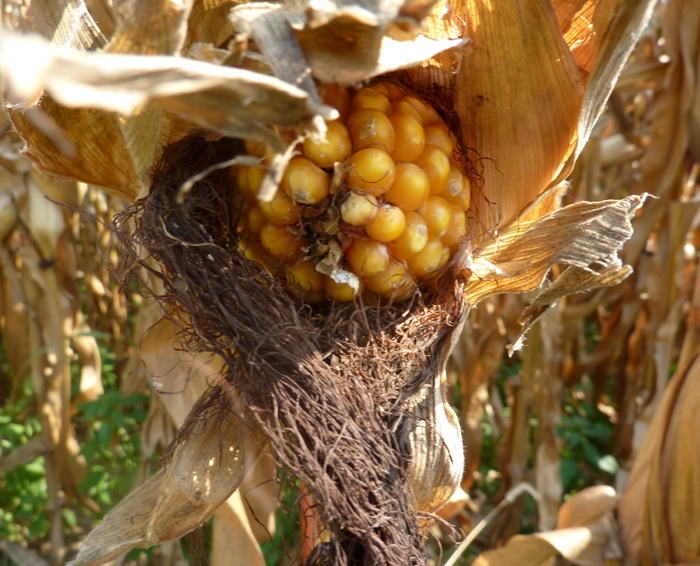
This new crop, maize, was very easy to cultivate in the lands of Northern Italy, and quickly replaced buckwheat and the other grains. The yield of maize compared to other cereals was much better, making it much more profitable a crop for landowners. Unfortunately, the nutritional value of maize is not as high as the grains it replaced, as it continued to act as a staple in the cuisine of the lower classes in Northern Italy. Today, maize is still the predominate grain used in polenta.
Vicenza is known for the production of the Marano variety of corn, which is considered by many in the Veneto region as the best corn flour for the preparation of polenta. In 1890, a local farmer, Antonio Fioretti, crossed two varieties of local corn, “nostrano” and “pignoletto d’oro”, in an eventually successful attempt to produce a strain that possessed the yield of the former with the quality of the latter. Strains with higher yields have since been developed, but the population continues to return to the Marano corn as its preferred polenta grain.
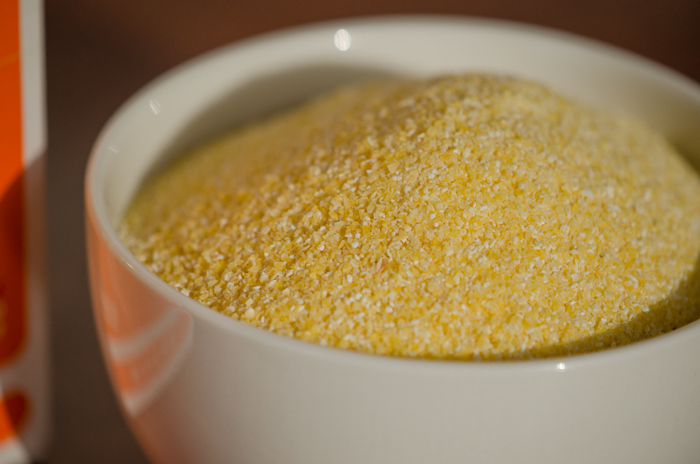
Marano, or Maranello corn, originated from Marano Vicentino. Marano corn is produced exclusively in the Leogra valley and the foothills of the Province of Vicenza, and the flour itself must be processed in Marano Vicentino or in the foothills of northern Vicenza, using only this Marano Vicentino variety. This variety is modest in size, with a rather short stalk with a high yield, producing many ears per stalk. It can withstand intense cultivation, and has a short growing cycle, making it a good option for crop rotation. The flour produced from it is very rich in gluten, producing a polenta with a good amount of elasticity, and an intense golden color with brown flecks.
The origin of this flour is certified by the “Consortium of the Land of Palladio”, and the Consortium for the Protection of Marano Corn has been founded to insure the continuing quality of the product.
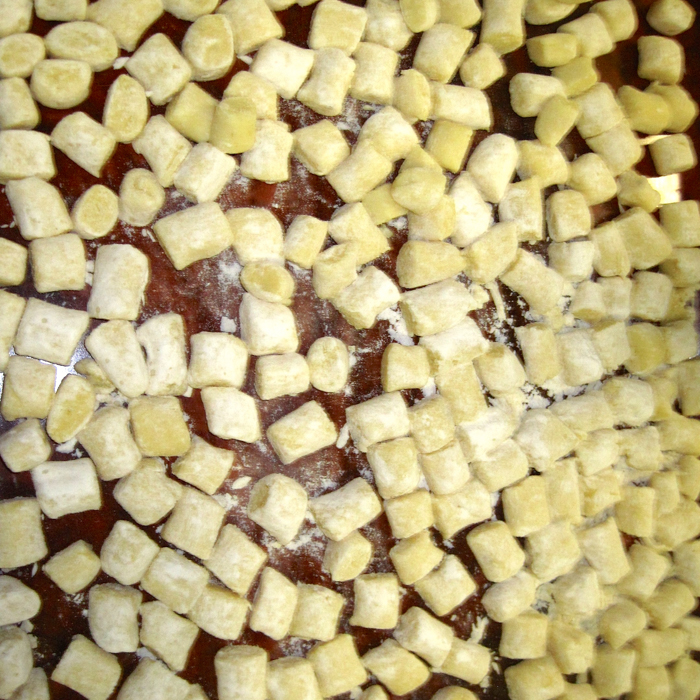
Pasta, a food synonymous with Italy, is not as common in the Northeastern regions as are other starches, notably polenta and gnocchi. Gnocchi is often based on potatoes, but here Trentino, Friuli-Venezia Giulia and the Veneto you will find an interesting variety of regional variations. Among the options, one will find gnocchi based on stale bread, ricotta and other cheese, semolina, buckwheat, spinach, meats like speck and even spleen.
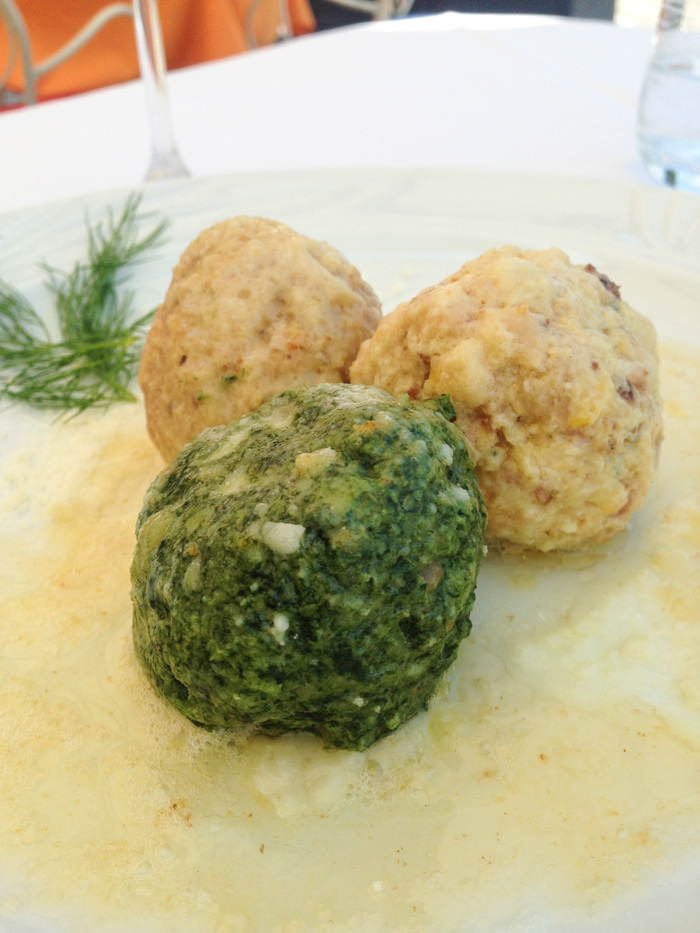
Canderli Trentini or Knodel
These are large gnocchi made with stale bread, milk, flour and egg, and flavored with a variety of different ingredients including salami, speck, spinach, nettles, cheese, and parsley. They are boiled in meat stock, and either served in the meat stock as a soup, or tossed in melted butter and served with grated cheese.
Knodel has its roots in Tyrolean cuisine, but canderli trentini are often a bit smaller, made only with white bread, and less fat.
Gratini
Gratini are tiny pasta similar to couscous in size. They are made from breadcrumbs, eggs, and cheese mixed together to form a still dough that is then grated to create its small grainy size. They are cooked in boiling stock, and are done immediately. Due to their dry texture, they keep for several days before cooking.
Nocken
A long thin shaped gnocchi di pane (bread gnocchi) from the Bolzano area. They can be flavored with spinach, buckwheat, beet greens, nettles, and cheese. They are served with melted butter and grated cheese.
Schlutzkrapfen
A semi-circular filled pasta from the Bolzano region, similar to ravioli or agnolotti. These are formed by cutting the pasta sheets into rounds, placing the filling on the round and folding it over and sealing. The filling is most commonly spinach and ricotta, flavored with onion and nutmeg. These are also served with melted butter and grated grana cheese.
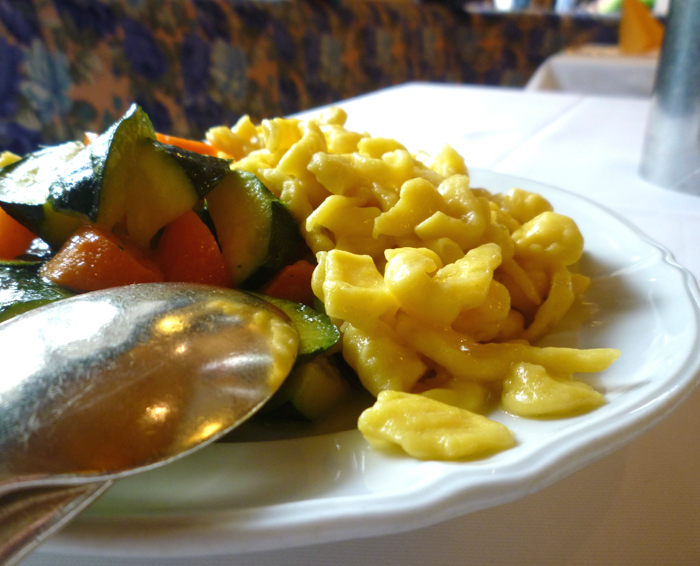
Spaetzle
An egg noodle found in the cuisine of the Bolzano region, as well as Austria, Germany, Hungary and Switzerland. The name is rumored to have its origins in the swabian word spitz, or “little sparrow”. Alternative theories claim it is based on the Italian verb spezzare, to break or split. This is a simple pasta, made of eggs, flour, salt and water. A strainer-like device is used to shape the spaetzle directly into the boiling water where they cook immediately. Spaetzle is served as an accompaniment to meat dishes with sauce. It is also used in soups. A rounder, more gnocchi shaped version is referred to as knopfle.
Schwarzplentene Spatzeln
These are small gnocchi made with buckwheat flour, cheese and melted butter. A specialized sieve is used to form these gnocchi.
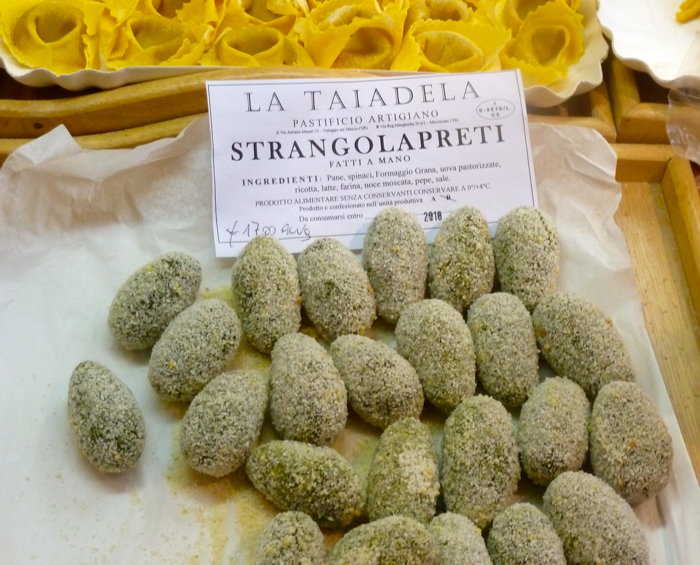
Strangolapreti
Green gnocchi made with spinach or other green vegetable such as kale or beet greens, stale bread, milk, eggs and flour. They are served with melted butter, cheese and sage. This dish was traditionally served on Fridays, when religious restrictions forbade the consumption of meat. As the legend goes, priests and other clergy members very much enjoyed this dish, and would eat it until they choked, hence the name strangolapreti, or priest stranglers.
Tirtlan
This filled pasta is made with dough that includes potatoes, white and rye flours, and onions. They are filled with spinach and ricotta.
In Italian, barley is “orzo”, providing much confusion for us Americans who are familiar with a rice-shaped small pasta by the same name. To make matters more confusing, Americans make a risotto type dish from this orzo pasta. In Friuli Venezia Giulia, a very typical regional dish is a ‘risotto’ made with barley, or orzo, called orzotto. I have seen recipes in the US for an orzotto, but often these are made with orzo pasta, not barley.
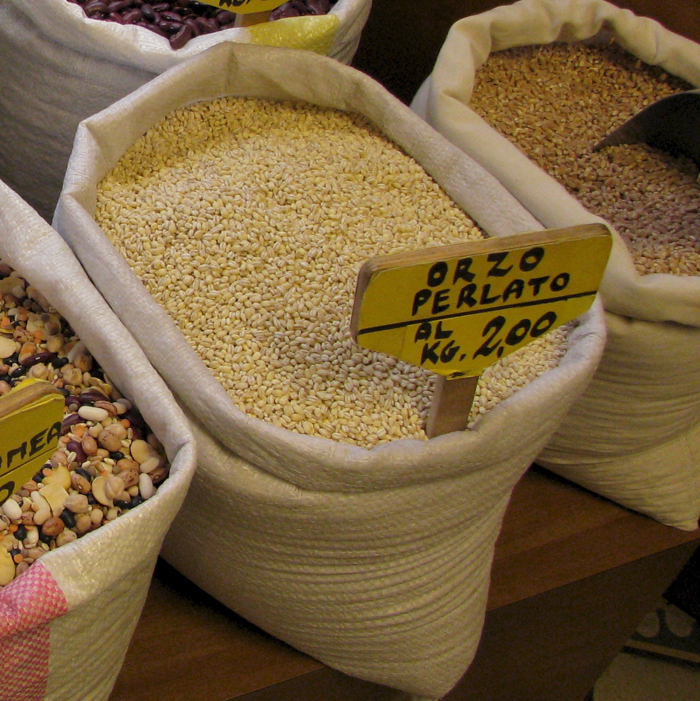
There are two types of barley found in Italy, mondo or hulled barley, which has been minimally processed to remove the hull. It is fiber-rich, and contains several high quality proteins. Perlato, or pearled barley, has been processed further in order to remove the germ and some of the bran. The grains are rounder, and it contains about 30% less nutrients. The mondo barley is used primarily in soups. The perlato barley cooks much faster, and is more often called for in recipes than the mondo type. When cooking with pearled barley, be aware that the amount of ‘pearling’ can vary from type to type, so the cooking time can vary significantly. The more it resembles a elongated grain, the longer it will take to cook.
Barley has been cultivated in Italy since ancient time, probably one of the first grains consumed in its wild form. Roman legionnaires would march off to battle with a bag of barley, which they would later boil in their helmets, making a hearty porridge. Its’ reputation for sustaining fighting forces was widespread; according to Pliny, barley was the special food of gladiators, who were also known as hordearii, or ‘barley eaters’.
Barley was replaced by more easily cultivated crops such as maize, or corn, and is no longer a commonly found grain in the Veneto region, but it appears occasionally in dishes like Crema d’Orzo al Latte (Barley Crema with Milk), a porridge type dish, similar to oatmeal in which barley replaces the oats. As we move north and east from the Veneto, however, we see more barley being cultivated and consumed today. It is particularly well-suited for cultivation at high altitudes, making it an important grain in the mountainous Trentino and Friuli-Venezia Giulia regions.
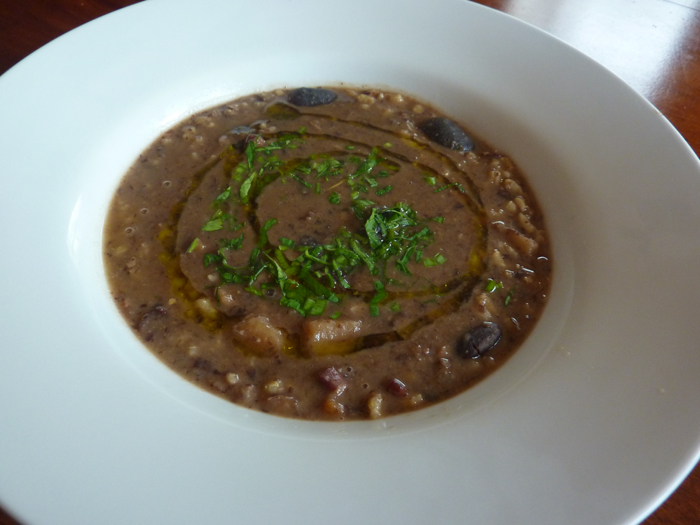
In Trentino, it is cultivated in the Adige valley, to the south of Bolzano. In this region, maize or corn is the most important grain, but wheat, oats and barley are grown here has well.
In Friuli Venezia Giulia, barley is one of the most important grains, having been introduced to the area by Jewish peoples who settled in Trieste. Here, the pasta e fagioli (pasta and bean soup) common throughout Italy morphs into orzo e fagoili, barley and bean soup. Also, risottos in this region become ‘orzotto’ when the Vialone Nano rice is replaced with orzo.


